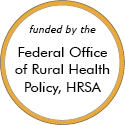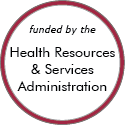Rural Project Examples: Health screening
Effective Examples
Kentucky Homeplace
Updated/reviewed October 2025
- Need: Rural Appalachian Kentucky residents have deficits in health resources and health status, including high levels of cancer, heart disease, hypertension, asthma, and diabetes.
- Intervention: Kentucky Homeplace was created as a community health worker initiative to provide health coaching, increased access to health screenings, and other services.
- Results: From July 2001 to June 2025, over 202,000 rural residents were served. Preventive health strategies, screenings, educational services, and referrals are all offered at no charge to clients.
New Mexico Mobile Screening Program for Miners


Updated/reviewed April 2025
- Need: To increase access to medical screening for miners in New Mexico.
- Intervention: A mobile screening clinic with telemedicine capability screens miners for respiratory and other conditions.
- Results: In a survey, 92% of miners reported their care as very good, while the other 8% reported it as good. The program has expanded to three other states.
Franklin Cardiovascular Health Program (FCHP)
Updated/reviewed March 2025
- Need: To develop sustainable, community-wide prevention methods for cardiovascular diseases in order to change behaviors and healthcare outcomes in rural Maine.
- Intervention: Local community groups and Franklin Memorial Hospital staff studied mortality and hospitalization rates for 40 years in this rural, low-income area of Farmington to seek intervention methods that could address cardiovascular diseases.
- Results: A decline in cardiovascular-related mortality rates and improved prevention methods for hypertension, high cholesterol, and smoking.
The Health-able Communities Program

Updated/reviewed August 2024
- Need: Expand healthcare access for the more remote residents of 3 frontier counties in north central Idaho.
- Intervention: With early federal grant-funding, a consortium of healthcare providers and community agencies used a hybrid Community Health Worker model to augment traditional healthcare delivery services in order to offer a comprehensive set of health-related interventions to frontier area residents.
- Results: With additional private grant funding, success continued to build into the current model of an established and separate CHW division within the health system's population health department.
Livingston County Help For Seniors

Updated/reviewed May 2020
- Need: Meeting the health needs of geriatric patients in rural Livingston County, New York.
- Intervention: The Help for Seniors program was developed and using its 'vodcasts,' local EMTs were trained in geriatric screening methods and health needs treatment.
- Results: In addition to developing a successful model for educating EMS personnel, the program screened over 1200 individuals and identified various risks among the geriatric population.
Other Project Examples
Pacific AIDS Education and Training Center-Nevada

Updated/reviewed April 2025
- Need: To improve and increase prevention and care services for HIV, STDs, hepatitis C, and other infectious diseases.
- Intervention: PAETC-NV provides clinical and didactic trainings, conferences, technical assistance, capacity building, webinars, and other services to providers and healthcare organizations statewide.
- Results: In 2024, PAETC-NV trained more than 1,800 healthcare providers across Nevada to increase clinical capacity in the care, screening, and prevention of HIV, other sexually transmitted diseases, and hepatitis C.
Healthy Mujeres in the Texas Rio Grande Valley
Added December 2024
- Need: To provide basic pregnancy-related and preventive health services to women in the Texas Rio Grande Valley.
- Intervention: A mobile clinic travels to different communities and provides basic preventive care, contraception, and pregnancy testing and ultrasounds.
- Results: Since the program began, clinical staff have provided services to nearly 6,000 women.
Schoharie County ACEs Team
Updated/reviewed December 2023
- Need: Agencies in Schoharie County, New York were seeing a widespread trend of Adverse Childhood Experiences (ACEs) in the children and families they served.
- Intervention: The Schoharie ACEs Team was formed as a way to educate rural communities about ACEs, the associated brain science, and ways to build resiliency.
- Results: The ACEs Team has put on 5 half-day educational conferences, 2 virtual conferences, and 10 trainings for various groups across the region. The team has also trained 3 school districts on trauma-informed care and provided resources for families exposed to trauma.
HealthStreet Cognitive Screening Project
Updated/reviewed November 2023
- Need: Because of the benefits associated with early identification of conditions causing memory problems, Florida's rural populations will benefit from access to screening for possible Alzheimer's Disease and other types of dementia.
- Intervention: A state university uses a state health department grant to develop a cognitive impairment screening program implemented by rural Community Health Workers. An additional grant provides rural medical practitioners with a free online continuing education module covering cognitive impairment and dementia.
- Results: To date, over 400 individuals have completed health screenings and over 900 referrals have been made to community social and medical services. At grant cycle completion, formal analysis of cognitive screening and referral to medical services will be shared.
Healthy Men Michigan
Updated/reviewed November 2023
- Need: Mental health assessment and referral to resources for men in rural Michigan who struggle with depression and suicidal thoughts.
- Intervention: The Healthy Men Michigan campaign was a research study testing online screening for depression, including irritability and anger, and suicide risk in working-aged men. The Healthy Men Michigan campaign website also provided referrals to local and national resources specific to men's mental health and suicide prevention.
- Results: More than 5,000 individuals completed anonymous online screenings and 550 men enrolled in the study. Healthy Men Michigan secured partnerships with over 225 individual and organizational partners, including healthcare facilities, small businesses, and recreational groups across the state. Together, their efforts have helped to promote screenings, reduce stigma, and encourage help-seeking behavior to prevent suicide.
For examples from other sources, see:
